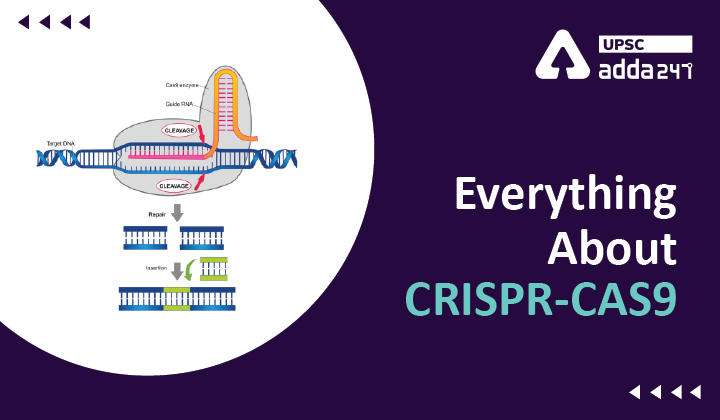Table of Contents
CRISPR CAS9 UPSC
CRISPR-CAS9 is a genome editing tool that is creating a lot of news in the science world. It is considered highly significant in biotechnology and medicine. In this article, we will discuss about various issues revolving around CRISPR and CAS9 that are important for UPSC exam.
Before we discuss about CRISPR, let us first understand
What is genome editing?
- Genome editing or gene editing is a group of technologies that give scientists the ability to change an organism’s DNA.
- Through these technologies, a genetic material can be added, removed or altered at any particular locations in the genome.
- Among the many approaches to genetic editing, CRISPR-CAS9 is one of them.
- The CRISPR-Cas9 system has generated a lot of buzz in the scientific community because it is faster, cheaper, more accurate, and more efficient than previous techniques of editing DNA and has a wide range of potential applications.
What is CRISPR-CAS9?
- As already discussed, CRISPR-Cas9 is a unique technology that enables scientists to edit parts of the genome by removing, adding or altering sections of the DNA sequence.
- CRISPR full form: Clustered Regularly Interspaced Palindromic Repeats.
- CRISPRs are specialized stretches of DNA, and the protein Cas9 (“CRISPR-associated”) is an enzyme that acts like a pair of molecular scissors, capable of cutting strands of DNA.
How CRISPR-CAS9 works?
- The CRISPR-CAS9 consists of two key molecules that introduces a change in the DNA. They are:
- Cas9: It acts as a pair of ‘molecular scissors’ that can cut the two strands of DNA at a specific location in the genome so that bits of DNA can then be added or removed.
- A piece of RNA called guide RNA (gRNA): The guide RNA is designed to find and bind to a specific sequence in the DNA.
What are the steps in CRISPR-CAS9?
- Select an organism for the experiment
- Select a gene of the target location
- Select a CRISPR-CAS9 system
- Select and Design the sgRNA
- Synthesizing and cloning of sgRNA
- Delivering the sgRNA and CAS9
- Validating the experiment
- Culturing the altred cells
- Gene expression study
- Analyzing results
Advantages of gene editing
- Tackling and defeating diseases: Genetic editing can be used to develop new immunotherapy that can treat cancer. Also, with the help of genetic editing, the scientist can prevent the inherent disease from flowing to the offspring.
- Extend lifespan: Genetic editing can reverse the most fundamental reasons for the body’s natural decline on a cellular level. So, it can improve both the span and the quality of life later on.
- Quality growth in food production: Genetic engineering can produce foods that can withstand harsh temperatures and are packed full of all the right nutrients. Genetic engineering can be the answer of all the nutrition problems around the world.
- Pest resilient crops: Genome editing can be a perfect alternative to tons of insecticides and pesticides that we use on a regular basis to make our crop healthy.
जीनोम संपादन तथा क्रिस्पर-कैस9: परिभाषा | कार्यकरण | लाभ | चुनौतियां
Challenges of gene editing
- Ethical dilemma: One of the most basic questions posed before gene editing is it un-naturalness. Gene editing is unnatural and by altering the laws of nature, scientists are doing more harm to the humankind.
- Safety concerns: Gene editing is a highly complex phenomenon. Slight changes made at the smallest level may lead to unexpected results. It is not clear what could be the fallouts of the research and how equipped we are to deal with such critical issues.
- Against diversity: Genetically engineering our species will have a detrimental effect on our genetic diversity, a key to evolution on earth.
- Affordability: Gene therapy is costly. So, the advantages of gene therapy could be only for the rich ones while the poor ones will hardly be benefitted from such technology.
Conclusion
- Genetic engineering is here to stay despite its criticisms.
- It would be better to put forward laws and regulations to regulate the technology to bring the best outcome.
- With proper laws and control over its usage, it will definitely be a huge gift for humankind.





 TSPSC Group 1 Question Paper 2024, Downl...
TSPSC Group 1 Question Paper 2024, Downl...
 TSPSC Group 1 Answer key 2024 Out, Downl...
TSPSC Group 1 Answer key 2024 Out, Downl...
 UPSC Prelims 2024 Question Paper, Downlo...
UPSC Prelims 2024 Question Paper, Downlo...
